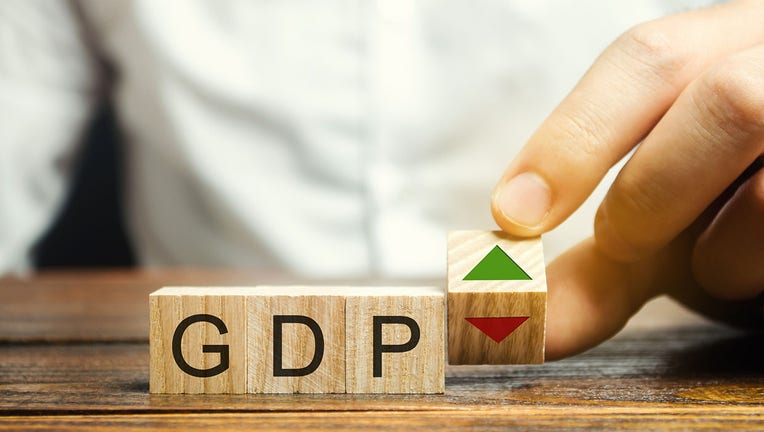Economic growth slows in Q3 to slowest pace since June 2020: This is how interest rates could be affected

Third quarter GDP growth dropped to just 2% in the advanced estimate. Here's what that means for interest rates. (iStock)
Economic activity slowed in the third quarter as real gross domestic product (GDP) dropped to an annual increase of 2% – the slowest pace since June 2020 – according to the advanced estimate released Thursday by the U.S. Bureau of Economic Analysis (BEA). This represents a significant slowdown compared to the GDP's 6.7% growth in the second quarter.
The slowdown was brought on by a decrease in residential investments, federal government spending and exports. Imports, which are a subtraction from the GDP growth rate, increased in the third quarter. Economists also explained that the slowdown was due to disruptions caused by an uptick in COVID-19 cases from the delta variant and supply-chain bottlenecks.
"Economic growth in the third quarter slowed down due to a temporary surge in the Delta virus, worsening supply chain disruptions and labor shortages," said Dawit Kebede, Credit Union National Association (CUNA) senior economist. "Consumer spending decelerated in this period because of declining auto sales due to computer chip shortages. Delta also slowed the increased momentum in travel and hotel spending seen in the previous quarter.
"As Delta cases continue to subside, there may be more growth in the fourth quarter as consumers will be more willing to spend on services involving in-person interactions," Dawit said. "The supply chain challenges, however, will likely continue until next year making it difficult to satisfy increased consumer demand."
If reduced economic growth has had a negative impact on your finances amid the country's recovery from the COVID-19 pandemic, consider taking out a personal loan to help meet personal expenses. You can use it to consolidate other high interest debt when interest rates are at historic lows. Visit Credible to find your personalized rate and see how much you could save.
FANNIE MAE AGAIN LOWERS ECONOMIC GROWTH OUTLOOK: WHAT IT MEANS FOR INTEREST RATES
What does slower economic growth mean for interest rates?
The reaction from the Federal Reserve to lackluster economic growth would typically be to consider lowering interest rates. Economists explained, however, that the third quarter’s low GDP is not due to a lack of consumer spending but rather a lack of supply.
"Following several quarters of a robust economic recovery, the pace of activity slowed in the third quarter as household spending growth on durable goods declined – most notably for motor vehicles – while spending on services remained stronger," said Mike Fratantoni, Mortgage Bankers Association (MBA) senior vice president of research and chief economist. "This distinction highlights the supply chain issues that continue to bedevil the economy. Consumers are willing and able to spend, but the goods are just not available. That description certainly includes the housing market, as residential investment declined again for the quarter, a witness to builders’ ongoing struggles to obtain key construction inputs."
Because consumers are still ready and able to spend, the Fed will likely continue on its current course to raise rates beginning in 2022. If you want to take advantage of low rates now before they increase, consider refinancing your home loan to save potentially hundreds of dollars per month. Visit Credible to compare multiple mortgage lenders at once and find the one that is the best fit for you.
MBA ECONOMIST SAYS INFLATION NOT TRANSITORY: HERE’S WHAT THAT MEANS FOR INTEREST RATES
Inflation could drive interest rates higher
The current-dollar GDP increased by 7.8% annually in the third quarter, or $432.5 billion to a total of $23.17 trillion. Comparatively, current-dollar GDP grew 13.4% in the second quarter, or $702.8 billion.
This came as the price index for gross domestic purchases, the BEA’s key measure for inflation, rose 5.4% in the third quarter, down slightly from the increase of 5.8% in the second quarter. The PCE price index, which is another measure of inflation, increased 5.3% annually in the third quarter, down from 6.5% in the second quarter.
"Of note, the PCE deflator in the third quarter was increasing at 5.3% rate, with prices for goods rising at a 7.3% rate," Fratantoni said. "This is further evidence of the inflationary pressures impacting the broader economy."
As inflation rises, the Fed will face greater pressure to raise interest rates. If you want to take advantage of low rates now, take out a student loan refinance to refinance your private student loans and start saving money on your monthly payments. Visit Credible to speak to a student loan expert and get all of your questions answered.
Have a finance-related question, but don't know who to ask? Email The Credible Money Expert at moneyexpert@credible.com and your question might be answered by Credible in our Money Expert column.

